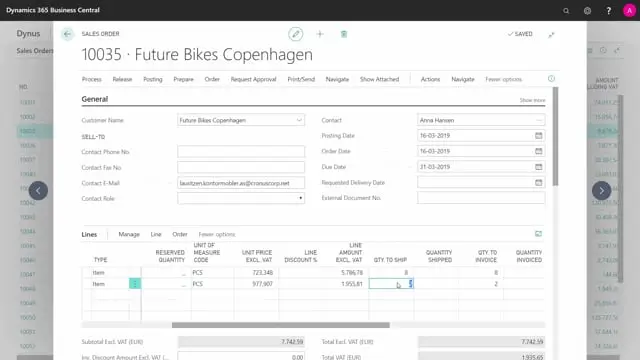Introduction to Setting Up Stockkeeping Units in Business Central
Managing inventory efficiently is crucial for any business, whether small or large. In today’s digital age, Dynamics 365 Business Central—Microsoft’s robust enterprise resource planning (ERP) solution—offers an innovative way to manage inventory. One of the key components of this system is Stockkeeping Units (SKUs). For those unfamiliar with the concept, this article will guide you through setting up SKUs in Business Central, making the process simple and straightforward.
What is a Stockkeeping Unit?
A Stockkeeping Unit (SKU) is a distinct item, such as a product or service, identified in a business’s inventory by a unique identifier. SKUs allow businesses to track inventory more efficiently by housing critical information like price, manufacturer, and other attributes. Essentially, SKUs serve as the comprehensive code that simplifies inventory management, sales tracking, and reordering processes.
The Importance of Stockkeeping Units in Business Central
SKUs are fundamental in maintaining streamlined inventory management within Business Central. By setting up SKUs, you align your inventory management with advanced functionalities such as:
- Efficient Tracking: Accurate monitoring of product variants, locations, and attributes.
- Improved Ordering: Facilitating automated reorder processes based on real-time inventory data.
- Cost Management: Enhanced capability in keeping records of product costs and sales prices.
With Business Central’s inventory capabilities, businesses can enhance their operational efficiency significantly.
Setting Up Stockkeeping Units in Business Central
Let’s walk through the steps to set up SKUs within Business Central. Following these steps will ensure a smooth implementation process.

Step 1: Access the SKU Page
- Navigate to Stockkeeping Units: Begin by logging into your Business Central account. From the home screen, enter “Stockkeeping Units” in the search bar and select it from the list.
- Open the SKU List: This option will display all existing SKUs, if any. If you are setting up SKUs for the first time, the list may be empty.
Step 2: Create a New SKU
- Choose ‘New’: Click on the ‘New’ button to create a new SKU.
- Fill in General Information: You’ll need to provide basic information:
- Item No.: Choose the item number for which you’re creating an SKU.
- Location Code: Select the location where the item is stored.
- Variant Code: If applicable, select the variant for the item.
- Set Up Additional Attributes: Include any additional necessary attributes like Stockkeeping Unit Description, Item, or Product Group.
Step 3: Define Replenishment and Planning Details
- Replenishment System: Choose the system (purchase, production, assembly) appropriate for the SKU.
- Planning Parameters: Define lead times, reorder quantities, and safety stocks under planning parameters. This helps in creating a comprehensive plan for inventory management.
Step 4: Add Cost and Sales Details
- Unit Cost and Sales Price: Enter relevant data that will facilitate sales and cost tracking.
- Inventory Posting Group: Select the correct posting group to ensure all transactions are recorded accurately.
Managing Inventory with SKUs: Best Practices
Utilize Variants in Business Central
In many businesses, products come in variations—size, color, or model. Business Central’s SKU function allows management of these variants efficiently. When creating SKUs for variants, ensure you differentiate using variant codes for better tracking.
Regularly Update SKU Information
Inventory is dynamic, and so should be the SKU data. Regular updates ensure accuracy and prevent misunderstandings related to stock levels and product details.
Table: Example of SKU Attributes
| Attribute | Example Data |
|---|---|
| Item No. | 102030 |
| Location Code | WH001 |
| Variant Code | RED |
| Replenishment System | Purchase |
| Lead Time | 5 days |
| Reorder Quantity | 100 units |
| Safety Stock | 20 units |
| Unit Cost | $15.00 |
| Sales Price | $25.00 |
Conclusion
Setting up Stockkeeping Units in Business Central is an essential process for robust inventory management. By following this guide, you can ensure that your SKU setup not only aids in reducing stock discrepancies but also enhances operational efficiency. Business Central’s capabilities, combined with efficiently managed SKUs, create a powerful backbone for business logistics and order management.
Frequently Asked Questions (FAQs)
What is a stockkeeping unit?
A Stockkeeping Unit (SKU) is a unique identifier for each distinct product and service that can be purchased. It simplifies inventory tracking and management by associating each item with a specific number.
How do you create a stockkeeping unit in Business Central?
To create a SKU in Business Central, navigate to Stockkeeping Units, choose ‘New,’ and fill in required information such as the item number, location, and variant code. Set additional attributes and planning details to complete the setup.
What are the benefits of using stockkeeping units?
SKUs streamline inventory management by providing distinct identifiers that make tracking, ordering, and inventory reporting more efficient. They also help in managing product sales and cost information accurately.
How do stockkeeping units differ from inventory items?
While inventory items refer to the actual products in stock, SKUs detail the specific characteristics and identifiers associated with each item, used for precise management and tracking.
Can you customize stockkeeping units in Business Central?
Yes, SKUs in Business Central are highly customizable. You can define various attributes, replenishment systems, and planning details to meet your specific business needs.
#MSFTAdvocate #AbhishekDhoriya #LearnWithAbhishekDhoriya #DynamixAcademy
References & Read More:
- Mastering Business Central Location Setup: A Comprehensive Guide for Beginners
- Understanding Financial Reports in Business Central: Step by Step Beginner’s Guide
- Microsoft Business Applications Launch Event 2024
- Comprehensive Guide to Setting Up Currencies in Business Central
- Mastering Editable Expressions in Visual Studio: A Beginner’s Guide
- How to Add Line Breaks in Email Descriptions Using Power Automate?
- Comprehensive Guide to Freeing Up Storage Space in Dynamics 365
- Understanding the New Landscape of Email Marketing Metrics: A Beginner’s Guide
- A Comprehensive Guide to Persistent Target Selection in Visual Studio 2022

1 thought on “Mastering Inventory Management: Setting Up Stockkeeping Units in Business Central for Beginners”